The global long-wear glucose sensors market is valued at USD 441.6 million in 2025 and is set to reach USD 1,074.4 million by 2035, recording an absolute increase of USD 632.8 million over the forecast period. This translates into a total growth of 143.3%, with the market forecast to expand at a CAGR of 9.3% between 2025 and 2035. The overall market size is expected to grow by approximately 2.4X during the same period, supported by increasing demand for continuous glucose monitoring solutions, growing diabetes prevalence globally, and rising applications across hospital pharmacies, retail pharmacies, and online pharmacy segments.
The global long-wear glucose sensors market represents a critical segment within the diabetes management and medical device industry, driven by the superior monitoring capabilities of extended-wear sensor products and the diverse functional properties of various glucose monitoring types. These specialized medical devices are produced through precision manufacturing processes, providing consistent healthcare standards and standardized performance characteristics for various diabetes management, clinical monitoring, and patient care applications including continuous glucose monitoring, diabetes therapy optimization, and specialized medical device operations. The processing mechanism enables controlled glucose detection development, making these products particularly suitable for diabetes patients and applications requiring specific blood glucose monitoring characteristics.
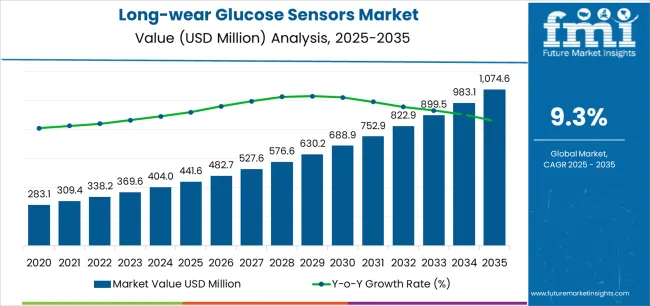
Between 2025 and 2030, the long-wear glucose sensors market is projected to expand from USD 441.6 million to USD 710.6 million, resulting in a value increase of USD 269.0 million, which represents 42.5% of the total forecast growth for the decade. This phase of development will be shaped by increasing diabetes management adoption, rising demand for alternative monitoring solutions, and growing availability of premium long-wear glucose sensor varieties across healthcare and pharmacy channels.
Between 2030 and 2035, the market is forecast to grow from USD 710.6 million to USD 1,074.4 million, adding another USD 363.8 million, which constitutes 57.5% of the overall ten-year expansion. This period is expected to be characterized by the advancement of specialty long-wear glucose sensor applications, the development of enhanced monitoring materials for diabetes improvement, and the expansion of certified long-wear glucose sensor availability across diverse healthcare and patient segments. The growing emphasis on continuous monitoring and advanced diabetes processing will drive demand for premium long-wear glucose sensor varieties with enhanced functional properties, improved monitoring characteristics, and superior performance profiles in specialized diabetes applications.
Between 2020 and 2024, the long-wear glucose sensors market experienced steady growth, driven by increasing awareness of diabetes management benefits and growing recognition of long-wear glucose sensors' effectiveness in healthcare applications following extensive diabetes care campaigns. The market developed as manufacturers recognized the advantages of long-wear glucose sensors over traditional monitoring alternatives in patient-sensitive applications and began seeking specialized products designed for specific monitoring and diabetes requirements. Technological advancement in medical technology and healthcare compliance began emphasizing the critical importance of maintaining healthcare integrity while enhancing functional performance and improving monitoring across diverse long-wear glucose sensor applications.
| Metric | Value |
|---|---|
| Estimated Value in (2025E) | USD 441.6 million |
| Forecast Value in (2035F) | USD 1,074.4 million |
| Forecast CAGR (2025 to 2035) | 9.3% |
From 2030 to 2035, the market is forecast to grow from USD 710.6 million to USD 1,074.4 million, adding another USD 363.8 million, which constitutes 57.5% of the overall ten-year expansion. This period is expected to be characterized by the advancement of specialized processing techniques in sensor production systems, the integration of quality enhancement protocols for optimal monitoring retention, and the development of customized sensor formulations for high-performance diabetes applications. The growing emphasis on material functionality and product reliability will drive demand for premium varieties with enhanced processing capabilities, improved storage stability, and superior healthcare performance characteristics.
Between 2020 and 2024, the long-wear glucose sensors market experienced robust growth, driven by increasing awareness of alternative healthcare benefits and growing recognition of specialized monitoring systems' effectiveness in supporting diverse diabetes operations across healthcare facilities and specialty patient care environments. The market developed as users recognized the potential for long-wear glucose sensor products to deliver functional advantages while meeting modern requirements for continuous monitoring and reliable healthcare performance. Technological advancement in processing optimization and quality enhancement began emphasizing the critical importance of maintaining material consistency while extending product durability and improving user satisfaction across diverse long-wear glucose sensor applications.
Market expansion is being supported by the increasing global emphasis on diabetes management and the corresponding shift toward alternative monitoring systems that can provide superior healthcare characteristics while meeting medical requirements for advanced monitoring solutions and cost-effective patient care options. Modern healthcare manufacturers are increasingly focused on incorporating monitoring materials that can enhance diabetes performance while satisfying demands for consistent, precisely controlled glucose detection and optimized healthcare profiles. Long-wear glucose sensors' proven ability to deliver healthcare excellence, functional versatility, and diverse application possibilities makes them essential materials for diabetes-focused professionals and quality-focused medical device manufacturers.
The growing emphasis on continuous monitoring and advanced diabetes processing is driving demand for high-performance long-wear glucose sensor systems that can support distinctive healthcare outcomes and comprehensive monitoring benefits across hospital applications, retail pharmacy distribution, and specialty online pharmacy manufacturing. Healthcare preference for monitoring solutions that combine functional excellence with advanced processing methods is creating opportunities for innovative implementations in both traditional and emerging diabetes applications. The rising influence of patient empowerment and alternative healthcare approaches is also contributing to increased adoption of long-wear glucose sensor solutions that can provide authentic functional benefits and reliable monitoring characteristics.
The market is segmented by product type, wear duration, application, and sales channel. By product type, the market is divided into transcutaneous patch CGM, implantable CGM, and accessories. Based on wear duration, the market is categorized into 10-14 days, 15-30 days, and 90-180 days. By application, the market includes type 1 diabetes, type 2 insulin-treated, type 2 non-insulin, and gestational diabetes. By sales channel, the market encompasses hospital pharmacies, retail pharmacies, online pharmacies/e-pharmacies, and e-commerce websites.
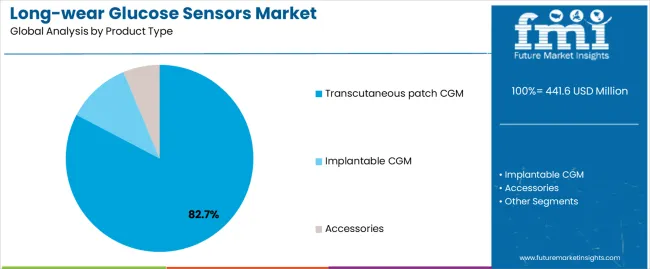
The transcutaneous patch CGM segment is projected to account for 82.7% of the long-wear glucose sensors market in 2025, reaffirming its position as the leading product category. Healthcare manufacturers and diabetes professionals increasingly utilize transcutaneous patch CGM technologies for their superior monitoring characteristics, established patient properties, and essential functionality in diverse diabetes applications across multiple healthcare sectors. Transcutaneous patch CGM's proven performance characteristics and established cost-effectiveness directly address user requirements for reliable monitoring control and optimal processing precision in hospital and specialty patient care applications.
This product segment forms the foundation of modern diabetes management patterns, as it represents the monitoring type with the greatest healthcare versatility and established compatibility across multiple medical systems. Healthcare industry investments in alternative medical technology and diabetes optimization continue to strengthen adoption among patient-focused manufacturers. With processors prioritizing monitoring reliability and functional consistency, transcutaneous patch CGM systems align with both performance objectives and healthcare requirements, making them the central component of comprehensive diabetes management strategies.
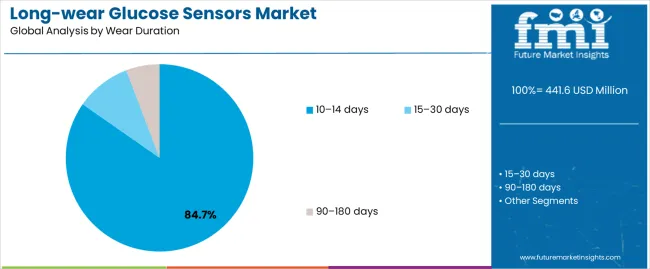
10-14 days is projected to represent 84.7% of the long-wear glucose sensors market in 2025, underscoring its important role as a key wear duration for performance-focused users seeking superior patient compliance and enhanced healthcare credentials. Healthcare facilities and diabetes operations prefer 10-14 days wear duration for their established performance characteristics, proven patient development, and ability to maintain exceptional healthcare precision while supporting versatile application coverage during diverse diabetes activities. Positioned as essential wear durations for quality-focused healthcare processors, 10-14 days offerings provide both functional excellence and healthcare optimization advantages.
The segment is supported by continuous improvement in medical technology and the widespread availability of established performance standards that enable quality assurance and premium positioning at the healthcare level. Additionally, healthcare facilities are optimizing wear duration selections to support application-specific requirements and comprehensive diabetes strategies. As medical technology continues to advance and facilities seek consistent wear duration performance, 10-14 days applications will continue to drive market growth while supporting operational efficiency and quality optimization strategies.
The long-wear glucose sensors market is advancing rapidly due to increasing diabetes management adoption and growing need for alternative monitoring solutions that emphasize superior healthcare performance across medical segments and specialty diabetes applications. The market faces challenges, including competition from other alternative monitoring types, price volatility in raw sensor materials, and processing complexity considerations affecting development costs. Innovation in medical technology enhancement and specialized monitoring formulations continues to influence market development and expansion patterns.
The growing adoption of long-wear glucose sensors with continuous certification and patient-friendly positioning is enabling healthcare companies to develop diabetes products that provide distinctive monitoring benefits while commanding premium pricing and enhanced patient appeal characteristics. Continuous applications provide superior market positioning while allowing more sophisticated product differentiation features across various healthcare categories. Healthcare companies are increasingly recognizing the market advantages of patient-friendly monitoring positioning for comprehensive diabetes outcomes and premium-focused healthcare marketing.
Modern long-wear glucose sensor manufacturers are incorporating advanced digital enhancement, performance improvement capabilities, and monitoring supplementation systems to enhance product functionality, improve diabetes effectiveness, and meet patient demands for enhanced healthcare solutions. These systems improve product performance while enabling new applications, including specialty diabetes programs and specialized healthcare protocols. Advanced performance integration also allows manufacturers to support premium product positioning and healthcare assurance beyond traditional monitoring performance requirements.
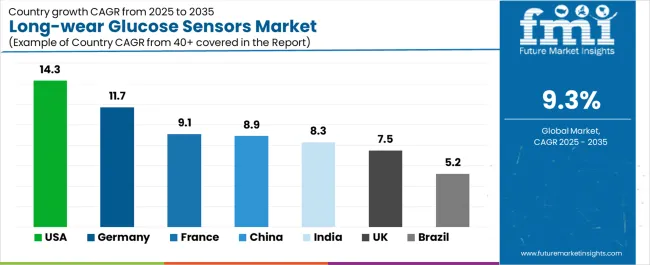
| Country | CAGR (2025 to 2035) |
|---|---|
| USA | 14.3% |
| Germany | 11.7% |
| France | 9.1% |
| China | 8.9% |
| India | 8.3% |
| UK | 7.5% |
| Brazil | 5.2% |
The long-wear glucose sensors market is experiencing robust growth globally, with USA leading at a 14.3% CAGR through 2035, driven by the expanding diabetes care sector, growing medical device adoption, and increasing adoption of glucose monitoring materials. Germany follows at 11.7%, supported by rising healthcare technology capabilities, expanding medical device industry, and growing acceptance of monitoring materials. France shows growth at 9.1%, emphasizing established healthcare standards and comprehensive monitoring development. China records 8.9%, focusing on healthcare industry modernization and diabetes care market growth. India demonstrates 8.3% growth, prioritizing advanced healthcare technologies and monitoring-focused medical products.
The report covers an in-depth analysis of 40+ countries, with top-performing countries highlighted below.
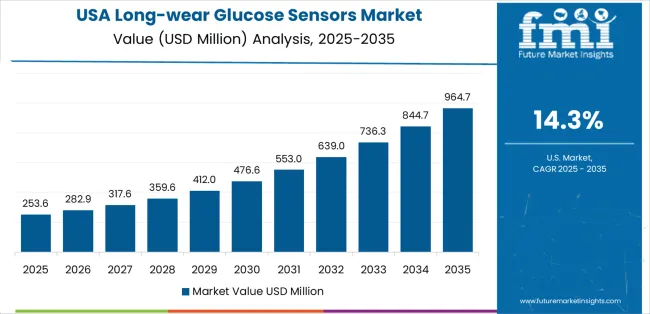
Revenue from long-wear glucose sensor consumption and sales in USA is projected to exhibit exceptional growth with a CAGR of 14.3% through 2035, driven by the country's rapidly expanding diabetes care sector, favorable healthcare policies toward medical devices, and initiatives promoting glucose monitoring development across major healthcare regions. USA's position as a global healthcare leader and increasing focus on processed monitoring materials are creating substantial demand for high-quality long-wear glucose sensors in both domestic and international markets. Major healthcare companies and device distributors are establishing comprehensive glucose sensor production capabilities to serve growing demand and emerging diabetes opportunities.
Demand for long-wear glucose sensor products in Germany is expanding at a CAGR of 11.7%, supported by rising domestic healthcare consumption, growing medical device technology adoption, and expanding monitoring distributor capabilities. The country's developing healthcare infrastructure and increasing investment in medical technologies are driving demand for long-wear glucose sensors across both traditional and modern healthcare applications. International device companies and domestic processors are establishing comprehensive operational networks to address growing market demand for alternative glucose sensor products and efficient monitoring processing solutions.
Revenue from long-wear glucose sensor products in France is projected to grow at a CAGR of 9.1% through 2035, supported by the country's mature healthcare processing standards, established medical device regulations, and leadership in specialty glucose sensor technology. France's sophisticated healthcare standards and strong support for alternative monitoring systems are creating steady demand for both traditional and innovative glucose sensor varieties. Leading device manufacturers and specialty distributors are establishing comprehensive operational strategies to serve both domestic markets and growing export opportunities.
Demand for long-wear glucose sensor products in China is anticipated to expand at a CAGR of 8.9% through 2035, driven by the country's emphasis on healthcare industry development, monitoring processing growth, and growing distributor capabilities. Chinese manufacturers and processing facilities consistently seek quality-focused devices that enhance product performance and support processing excellence for both traditional and modern healthcare applications. The country's position as an Asian healthcare leader continues to drive innovation in specialized glucose sensor applications and healthcare processing standards.
Revenue from long-wear glucose sensor products in India is projected to grow at a CAGR of 8.3% through 2035, supported by established healthcare standards, mature diabetes markets, and emphasis on medical device alternatives across healthcare and patient sectors. Indian manufacturers and specialty processors prioritize quality devices and consistent performance, creating steady demand for premium glucose sensor solutions. The country's comprehensive market innovation and established healthcare practices support continued development in specialized applications.
Demand for long-wear glucose sensor products in the UK is projected to grow at a CAGR of 7.5% through 2035, supported by established healthcare standards, mature diabetes markets, and emphasis on monitoring alternatives across healthcare and medical sectors. British manufacturers and specialty processors prioritize quality devices and consistent performance, creating steady demand for premium glucose sensor solutions. The country's comprehensive market maturity and established healthcare practices support continued development in specialized applications.
Revenue from long-wear glucose sensor products in Brazil is projected to grow at a CAGR of 5.2% through 2035, supported by the country's emphasis on device quality, healthcare excellence, and advanced processing technology integration requiring efficient device solutions. Brazilian healthcare facilities and quality-focused operations prioritize technical performance and healthcare precision, making specialized glucose sensors essential devices for both traditional and modern healthcare applications. The country's comprehensive healthcare leadership and advancing quality patterns support continued market expansion.
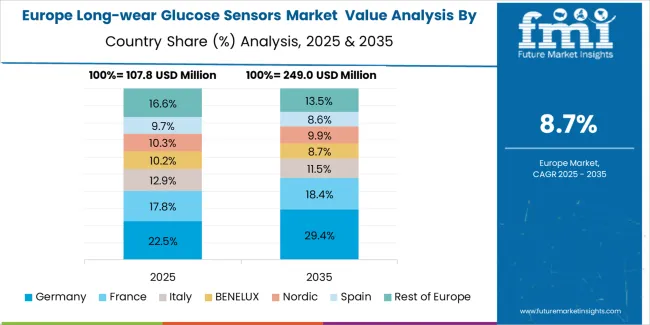
The Europe long-wear glucose sensors market is projected to grow from USD 118.8 million in 2025 to USD 276.3 million by 2035, registering a CAGR of 8.8% over the forecast period. Germany is expected to maintain its leadership position with a 27.9% market share in 2025, expanding to 36.1% by 2035, supported by its advanced healthcare infrastructure and major medical device hubs including Berlin and Munich.
France follows with a 17.2% share in 2025, projected to reach 17.7% by 2035, driven by comprehensive healthcare modernization programs and medical device initiatives. Italy holds a 12.1% share in 2025, maintaining 12.1% by 2035 due to steady device adoption. Spain commands an 8.3% share declining to 7.6% by 2035, while BENELUX accounts for 6.0% declining to 4.9% by 2035. The Rest of Western Europe region is anticipated to maintain significant presence, with its collective share declining from 25.2% to 18.9% by 2035, while Nordic countries hold steady at 3.4% to 2.7%, attributed to specialized diabetes care adoption and established glucose monitoring programs.
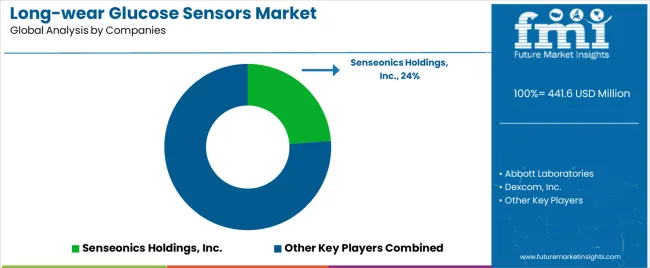
The long-wear glucose sensors market is characterized by competition among established medical device manufacturers, specialized glucose monitoring companies, and integrated diabetes care providers. Companies are investing in advanced medical technologies, specialized processing engineering, product innovation capabilities, and comprehensive distribution networks to deliver consistent, high-quality, and reliable long-wear glucose sensor products. Innovation in monitoring efficiency optimization, quality control advancement, and diabetes-focused product development is central to strengthening market position and customer satisfaction.
Senseonics Holdings leads the market with 23.8% share with a strong focus on medical device technology innovation and comprehensive diabetes solutions, offering healthcare and specialty systems with emphasis on quality excellence and monitoring heritage. Abbott Laboratories provides integrated advanced monitoring solutions with a focus on diabetes market applications and functional device networks. Dexcom delivers comprehensive glucose sensor products with a focus on healthcare positioning and diabetes quality. Medtronic specializes in medical-based monitoring systems with an emphasis on diabetes applications. F. Hoffmann-La Roche focuses on comprehensive glucose sensor processing with advanced medical technology and diabetes positioning capabilities. The combined other key players represent 76.2% of the market, indicating significant competition and market fragmentation among emerging device providers and specialized diabetes care companies.
| Items | Values |
|---|---|
| Quantitative Units (2025) | USD 441.6 million |
| Product Type | Transcutaneous patch CGM, Implantable CGM, Accessories |
| Wear Duration | 10-14 days, 15-30 days, 90-180 days |
| Application | Type 1 diabetes, Type 2 insulin-treated, Type 2 non-insulin, Gestational diabetes |
| Sales Channel | Hospital Pharmacies, Retail Pharmacies, Online Pharmacies/E-pharmacies, E-commerce Websites |
| Regions Covered | North America, Europe, Asia-Pacific, Latin America, Middle East & Africa |
| Countries Covered | USA, UK, Germany, France, Japan, South Korea, China, India, Brazil, and 40+ countries |
| Key Companies Profiled | Senseonics Holdings, Abbott Laboratories, Dexcom, Medtronic, F. Hoffmann-La Roche, and other leading long-wear glucose sensor companies |
| Additional Attributes | Dollar sales by product type, wear duration, application, sales channel, and region; regional demand trends, competitive landscape, technological advancements in monitoring processing, quality optimization initiatives, diabetes enhancement programs, and premium product development strategies |
The global long-wear glucose sensors market is estimated to be valued at USD 441.6 million in 2025.
The market size for the long-wear glucose sensors market is projected to reach USD 1,074.6 million by 2035.
The long-wear glucose sensors market is expected to grow at a 9.3% CAGR between 2025 and 2035.
The key product types in long-wear glucose sensors market are transcutaneous patch cgm , implantable cgm and accessories.
In terms of wear duration, 10–14 days segment to command 84.7% share in the long-wear glucose sensors market in 2025.






Full Research Suite comprises of:
Market outlook & trends analysis
Interviews & case studies
Strategic recommendations
Vendor profiles & capabilities analysis
5-year forecasts
8 regions and 60+ country-level data splits
Market segment data splits
12 months of continuous data updates
DELIVERED AS:
PDF EXCEL ONLINE
Glucose Sensor Market Size and Share Forecast Outlook 2025 to 2035
Glucose Oxidase Market Analysis – Trends & Forecast 2025-2035
Glucose-Fructose Syrup Market – Growth, Demand & Food Industry Trends
Glucose Monitoring Device Market Overview – Growth, Trends & Forecast 2024-2034
Glucose Syrup Market
OTC Glucose Monitors Market Size and Share Forecast Outlook 2025 to 2035
Blood Glucose Monitoring Devices Market Size and Share Forecast Outlook 2025 to 2035
Starch Glucose Syrup Market
Starches/Glucose Market
Diacetone Glucose Market Size and Share Forecast Outlook 2025 to 2035
Demand for Glucose Monitoring Devices in EU Size and Share Forecast Outlook 2025 to 2035
Continuous Glucose Monitoring Device Market - Demand & Future Trends 2025 to 2035
Continuous Glucose Monitoring Systems Market is segmented by transmitters and monitors, sensors and insulin pump from 2025 to 2035
Sensor Based Glucose Measuring Systems Market Size and Share Forecast Outlook 2025 to 2035
Non-Invasive Blood Glucose Monitoring Devices Market Size and Share Forecast Outlook 2025 to 2035
Network Point-of-Care Glucose Testing Market Size and Share Forecast Outlook 2025 to 2035
Sensors Market Analysis by Type, Technology, End User & Region - Forecast from 2025 to 2035
Biosensors Market Trends – Growth & Future Outlook 2025 to 2035
UV Sensors Market Analysis by Type, End User, and Region from 2025 to 2035
Nanosensors Market Size and Share Forecast Outlook 2025 to 2035

Thank you!
You will receive an email from our Business Development Manager. Please be sure to check your SPAM/JUNK folder too.
Chat With
MaRIA